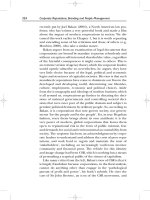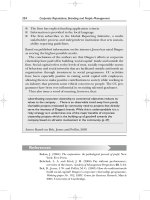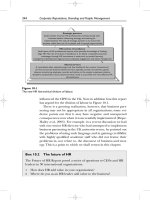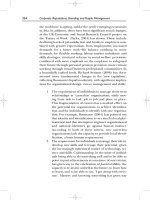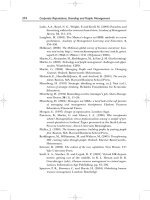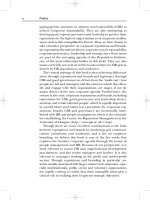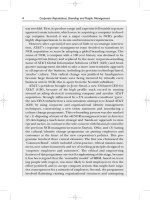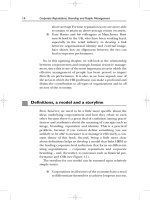Tài liệu Corporate Reputations, Branding and People Management 40 pdf
Bạn đang xem bản rút gọn của tài liệu. Xem và tải ngay bản đầy đủ của tài liệu tại đây (129.4 KB, 11 trang )
Lado, A.A., Boyd, N. G., Wright, P. and Kroll, M. (2006) Paradox and
theorizing within the resource-based view, Academy of Management
Review, 31, 115–131.
Langbert, M. (2005) The Master’s degree in HRM: midwife to a new
profession, Academy of Management Learning and Education, 4,
434–450.
McKinsey (2006) The McKinsey global survey of business executives: busi-
ness and society. />aspx?L2ϭ39&L3ϭ29&arϭ1741 (26 January 2006).
Martin, G., Alexander, H., Reddington, M., & Pate, J. M. (forthcoming)
Martin, G. (2005) Technology and people management: challenges and oppor-
tunities. Wimbledon: CIPD.
Martin, G. (2006) Managing People and Organizations in Changing
Contexts. Oxford: Butterworth–Heinemann.
Michaels, E., Handfield-Jones, H. and Axelrod, B. (2001) The war for
talent. Boston, MA: Harvard Business School Press.
Mintzberg, H. (1991) Strategic thinking as seeing, in J. Nasi (ed.),
Arenas of strategic thinking. Helsinki: Foundations for Economic
Education.
Mintzberg, H. (1994) Rounding out the manager’s job, Sloan Manage-
ment Review, 36 (1), 11–26.
Mintzberg, H. (2004) Managers not MBAs: a hard look at the soft practice
of managing and management development. Harlow: Pearson
Education/Financial Times.
Morgan, G. (1997) Images of organization. London: Sage.
Paterson, B., Martin, G. and Glover, I. A. (1988) Who incorporates
whom? Managerialism versus professionalism among a sample of per-
sonnel specialists in Scotland. Paper presented at the Sixth Labour
Process Conference, Aston University Birmingham.
Pfeffer, J. (1998) The human equation: building profits by putting people
first. Boston, MA: Harvard Business School Press.
Reddington, M., Williamson, M. and Withers, M. (2005) Transforming
HR: creating value through people. Oxford: Elsevier Butterworth–
Heinemann.
Sennett, R. (2006) The culture of the new capitalism. New Haven, CT:
Yale University Press.
Snell, S. A., Steuber, D. and Lepak, D. P. (2001) Virtual HR depart-
ments: getting out of the middle, in R. L. Henan and D. B.
Greenberger (eds), Human resource management in virtual organ-
izations, Information Age Publishing, pp. 81–102.
Sparrow, P. R., Brewster, C. and Harris, H. (2004) Globalizing human
resource management. London: Routledge.
374 Corporate Reputations, Branding and People Management
Strauss, G. (2001) HRM in the US: correcting some British impres-
sions, International Journal of Human Resource Management, 12, 873.
Taylor, R. (2004) Skills and innovation in modern Britain. ESRC Future
of Work Programme Seminar Series. />esrcfutureof work/downloads/fow_publication_6.pdf. (23
December 2005).
Tyson, S. and Fell, A. (1986) Evaluating the personnel function. London:
Hutchinson.
Ulrich, D. (1996) Human resource champions. Boston, MA: Harvard
Business School Press.
Ulrich, D. and Brockbank, W. (2005) The HR value proposition. Boston,
MA: Harvard Business School Press.
Van de Ven, A. H. and Poole, M. S. (1995) Explaining development
and change in organizations, Academy of Management Review, 20
(3), 510–540.
Watson, T. (1977) The personnel managers: a study in the sociology of work.
London: Routledge and Kegan Paul.
Watson Wyatt (2003) The HR scorecard alliance. Watson Wyatt Worldwide,
Washington, DC.
Weick, K. E. (2001) Making sense of the organization. Oxford: Blackwell.
Whittington, R. (2000) What is strategy and does it matter (2nd edition).
London: Thomson.
Wrapp, H. Edward (1967) Good managers don’t make policy deci-
sions, Harvard Business Review, Sept–Oct, 91–100.
Zhang, H. and Martin, G. (2003) Human resource management practices
in Sino-foreign joint ventures. Nanhchang: Jiangxi Science and
Technology Press.
Chapter 10 Creating a fit-for-purpose future 375
This page intentionally left blank
ABB 195
Acer 50
AC
3
ID framework 95–9
Action(s), organizational 25–7, 82, 83, 106–11
Age Concern North Tyneside 104–5
Ageing populations 6
Agilent Technologies 93, 111, 215
Agreeableness 101, 102, 103
Airlines, see British Airways; Southwest Airlines
America, see USA
Apple, as celebrity brand 22–3
Associations, as component of brand equity 53
AT&T, acquisition and re-branding of NCR
Corporation 3–5
Autobiography, organizational 21, 65, 106
Awareness, as component of brand equity 53
BA (British Airways), changing identities 97–9
Balanced scorecard 43
‘Banco (South)’ 192–4, 205–6, 213
Banking
service-profit chain 28, 45–6
UK 299
see also Financial services industry
Banks
performance drivers 207
strategic activities 207
see also ‘Banco (South)’; Banking; HSBC; Royal
Bank of Scotland Group
Barney, Jay 41
Beckham, David 94
BenQ 49–50
Best Companies 274–5
Best practice(s) 229–30
borrowing and diffusion of 240
generic 204
human resource management (HRM) 162–3,
165–9, 174–8
Biography, organizational 21, 65, 258
Body Shop 12
Brand equity 52–3
components 52–3
definition 52
see also Employer brand equity
Brand identity 55, 57–8
vs brand reputation 58
definition 57
Branding
corporate, see Corporate branding
developments in 46–7
employee branding 116, 281–5
employer branding 277–88
global vs local 338–41
interpretations of 53–8
mistakes 9
monolithic 19
research 53–60
roles of 54–6
Brands
American 2
business success and 47–8
celebrity brands 22–3
definition 47
driving business success 8–11
house of brands 19, 62
as intangible assets 10–11
reputation 57–8, 74
social value of 50–2
super-brands 22, 74–5
top ten 11
value of 48–9
see also Brand equity; Brand identity;
Branding
Brandwashing 27
British Airways (BA), changing identities 97–9
British American Tobacco (BAT) 52
British Army, talent management in 287–8
Business partnering 183, 184, 344
Business success, reputation and brands driving
8–11
Index
Business systems 240–8
critical turning points 246–7
historical development of 241–5
interlocking/enduring nature of 245–6
international comparisons 248
national 220–1, 240–1
new industries 245
Capital
human, see Human capital
reputational 11–13, 64–5
social 195, 330, 334
Capitalism, new 354
Cappelli, Peter 215–16
Change
through communications 267–72, 361–2
conception stage 269, 270–1
embedding stage 269, 272
feedback stage 272
focus on 217–20
narrative for 264–5
receptive contexts for 268–70
sustainable, definition 267
transition stage 269, 271
Change conversations 267–8
Change programmes 220
Character, see Corporate character
Chartered Institute of Personnel and
Development (CIPD) 320–1
Chicness 102
China
brand building 50
joint ventures 67, 172
shortage of graduates 273
Collectivist societies 237–8
Commitment 116, 144–6
affective 140, 144, 146
attitudinal 144
to career 201
continuance 145, 145–6
Global Employee Commitment Report 201–2
high commitment management 174–5
measuring and managing 135–6
normative 145
to the organization 144–6, 147, 201
Communication(s)
change through 267–72, 361–2
corporate, see Corporate communications
management communication 266
marketing communication 266
organizational 266
strategy as 265
Competence 101–2
Competitive advantage, sources of 203, 206–7
Confidence, as outcome of reputation 75
Conformance to standards of behaviour 8
Consumers
classification 355–7
declining levels of confidence 8–9
purchasing decisions 13
Contract workers 183–4
Contracts, see Ideological contracts; Psychological
contracts
Cooperation, and initiative, balance between 1, 7
Core competency school of strategic advantage
306–7
Core internal competences 43–6
Core workforce differentiation 204–5
Corporate branding 6–7, 17, 18–20, 59–60, 60–4
essentials of 13
in multinational enterprises 229–30, 241
see also Branding; Brands
Corporate character 69–70, 101
Age Concern North Tyneside 104–5
dimensions of 101–4
Corporate Citizenship Programme, Diageo 330–4
Corporate communications 17
changing 263–6
description 265–6
failures in 257–8
importance of 257–62
re-branding Orange 259–62, 263–4, 268
‘strategy-as-narrative’ 258
see also Communication(s)
Corporate governance 296, 309–11
agency theory 312–14
approaches to 312–17
enlightened shareholder value model 316–17
irregularities 8–9, 65, 316
models of 296
stakeholder theory 312, 314–15
stewardship theory 312, 314–15
see also Governance
Corporate identity 17
and corporate social responsibility 317–18
Corporate image 17, 20–3
Corporate interests, encroachment of 9–10
Corporate reputation(s) 6–7, 17, 64–5
definition 70–1
in times of crisis 64–5
Corporate social responsibility (CSR) 8, 12,
50–2, 296–7
business case for 319–21
case for 318–19
and corporate identity 317–18
criticisms of 322–9
GE 310–11
measurement 321–2, 328–9
triple bottom line (3BL) 321–2, 328
Corporate strategy
inside-out perspective 302–5
outside-in approach 302, 309
378 Index
